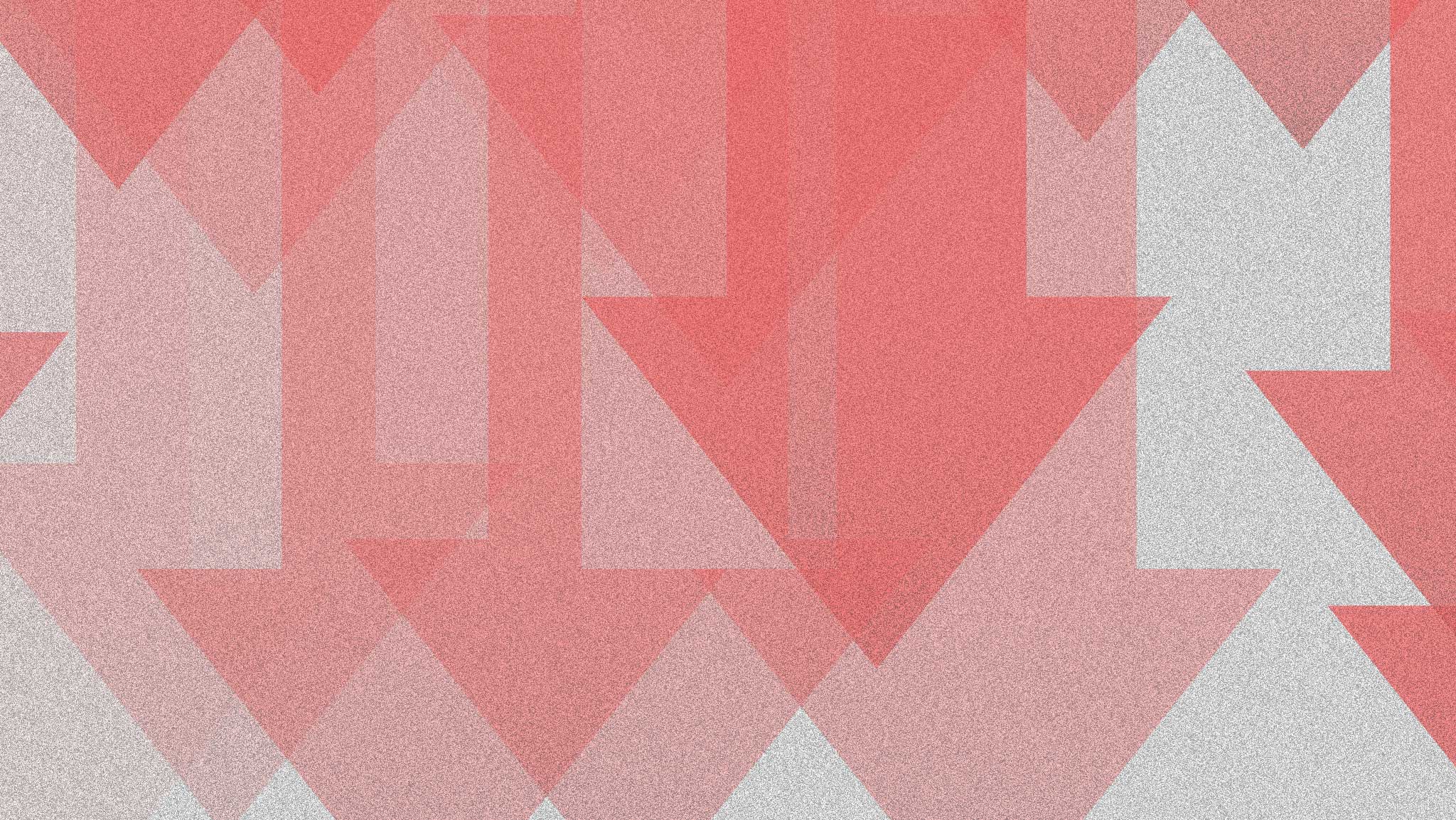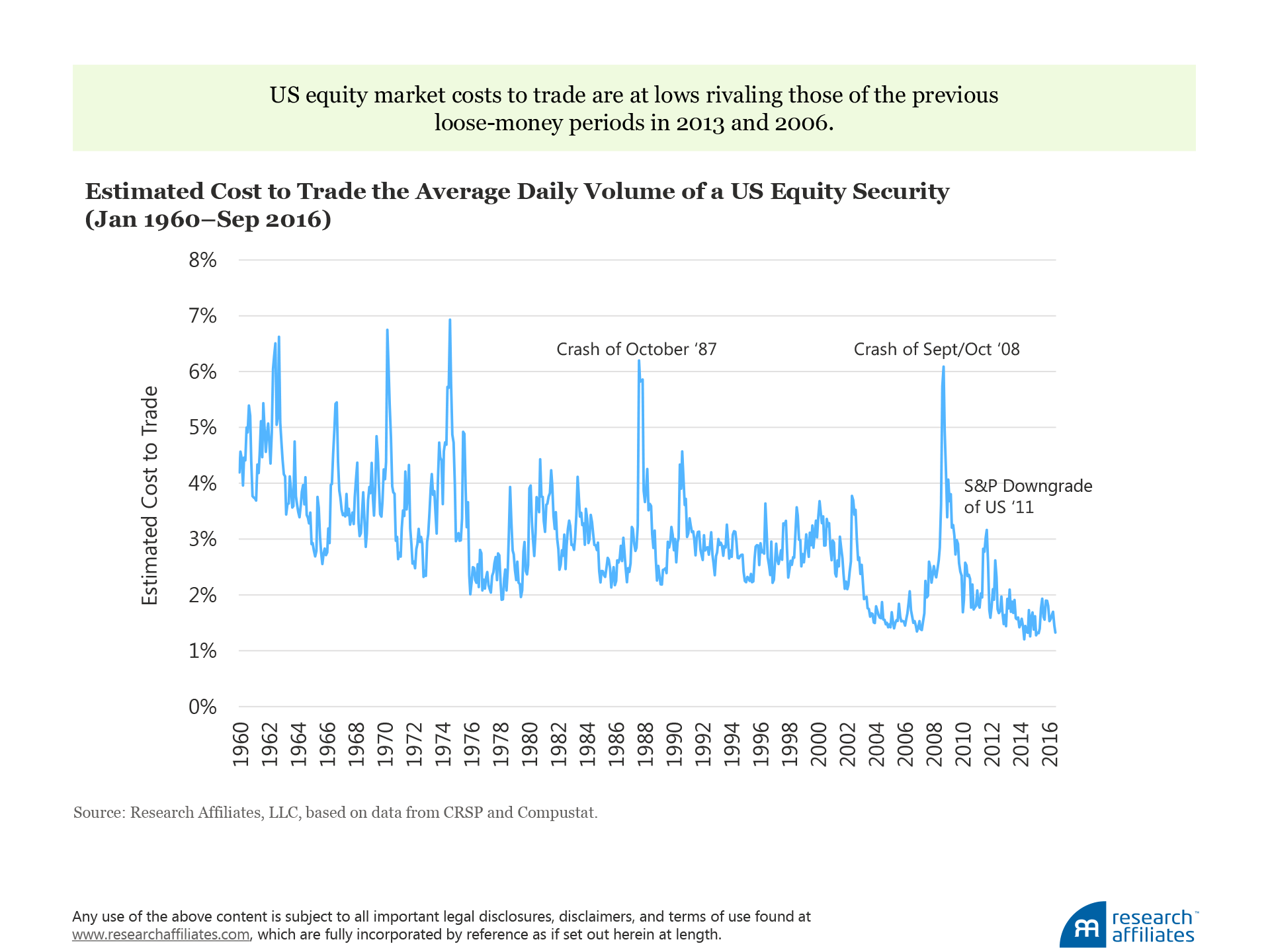
Trading costs for US equities are at their lowest levels since 1960.
Historical experience shows trading costs can rise quickly, and the impending return to normal levels from current levels could shave 5% off the price of US stocks.
Luckily, liquidity is a mean-reverting process. Its value can be inferred up to 12 months in the future, allowing time to position portfolios for greater protection or potential profit.
We live in a time of unprecedented fee compression, from online merchants offering free two-day shipping and content distributors extending free digital streaming to, yes, even liquidity providers affording lower costs in asset trading. Low costs, however, can sometimes be less a perk than a harbinger of danger. For investors who have spent decades investing in cheap assets, to think that cheap is not always good is a confounding concept, especially if that economy comes in the form of transaction costs. This is because transactions costs, like valuations, are mean reverting: low transactions costs today point to higher transactions costs tomorrow.
For many investors, the subject of trading costs and market liquidity automatically brings on a long, slow yawn. We, however, want not only to provide background on this topic, but to highlight how you can protect against, and potentially profit from, changing levels of liquidity.
Current Costs to Trade
Extremely low trading costs at the end of 2015 rose abruptly in early 2016 following the Fed’s decision to increase short-term rates. Astute, tactically minded investors, who recognized the link between changes in short rates and liquidity, understood that the drop in equity prices in January and February was a temporary phenomenon driven not by changes in fundamentals, but by changes in the costs to trade. At that time, higher trading costs resulting from lower liquidity levels drove down overall prices and unlocked the opportunity for a quick profit for buyers of US stocks. Compared to other historical liquidity episodes, the 2016 event is a minor blip. Nonetheless, the S&P 500 Index rebounded a stunning 12% from its low in mid-February through its recovery at the end of March.
After some unsettling market movements, the saber rattling died down in early spring, and the United States returned to record-breaking levels of cheap money. Usually a bond story, the Fed’s open-market actions, this time around, have been associated with meaningful equity market swings. The costs to trade in the US equity market are now back to historical lows—at the end of August 2016, 1.3%—consistent with the loose-money environments of 2006 and 2013.

Costs to Trade and Liquidity
At its most basic level, the liquidity of an investment defines the ability of a trader to convert a large quantity of the asset into cash at a low cost and with little price impact (Pastor and Stambaugh, 2003). The more liquid an asset, the cheaper it is to trade. All other things being equal, an investor would prefer a liquid to an illiquid asset, especially if the expected holding period is short.
The average cost to trade varies by type of security and timing of the transaction. The basic cost structure is familiar. At one end of the spectrum, trading benchmark US Treasury notes costs little per notional; at the other, moving a large portion of small-cap emerging market securities in the after-market is very expensive. For a very popular (i.e., mid-spectrum) market, Aked and Moroz (2015) found in their internal empirical analysis that a small lot of listed US equity securities cost, on average, 3% for each block of average daily volume. Therefore, to trade 10% of the daily volume of a security, the costs to execute, on average, should be about 0.3%.
Most asset classes—stocks, bonds, currencies, commodities, and derivatives, among others—are viewed as trading frequently, and therefore as being liquid. The illiquid designation is generally reserved for assets such as real estate, timber, art, private equity, and hedge funds that trade less frequently and not on an organized exchange. The liquid–illiquid classification is based on average trading costs over time. As we’ve shown, however, the cost of trading is not fixed. During times of economic stability and abundant financial opportunities attracting liquidity providers is easy, whereas at times of greater uncertainty, finding liquidity providers is difficult. When liquidity is scarce, the cost to trade rises as does the opportunity to profit, sometimes significantly.
What Defines Market Liquidity
Under normal conditions, across all markets, potential liquidity providers require price concessions because they assume, or fear, that investors requiring liquidity have an asymmetric information advantage. Brunnermeier and Pedersen (2009) find that liquidity
- is positively related to volatility.
- has a varying impact based on the commonality across securities.
- can at times co-move across markets.
Illiquidity often coincides with times of high volatility, and the nature of illiquidity varies based on the commonality across securities. Commonality defines the rate at which securities in a market move together. Said another way, markets with high commonality see a broad swath of securities reacting similarly to market events, whereas markets with less commonality show a more diffuse response by securities to the same events. In the cross-section, illiquidity opportunities exist in securities that display some amount of idiosyncrasy from similar securities.
Lower commonality, offering more opportunities for idiosyncratic illiquidity, occurs in markets with greater transparency and access to information. These markets usually have less correlated assets and lower average volatility. In contrast, higher-commonality markets are viewed as riskier because they usually have weaker legal protection and property rights controls. As a generalization, developed markets usually have lower commonality, whereas emerging markets tend to exhibit higher commonality.
During periods of crisis and high volatility, investors will unconditionally sell assets from more opaque markets where differentiation is more difficult. In more transparent markets, however, opportunities for segmentation exist, and liquidity is one of the factors investors take into account.
Measuring the Costs to Trade
Market analysts use a number of traditional liquidity measures to estimate the costs of trading. These fall into two buckets: heuristic/market-based methods and theory-based methods. These metrics can apply to any market, but in this article we apply them to the S&P 500.
Market-based methods include 1) the family of spread characteristics: the bid–ask, effective, and realized spreads; 2) market depth, a measure of the quantity of limit orders at either the bid or the ask price, and 3) turnover statistics, which measure average trading activity as a proportion of total fund assets. These methods have the benefit of simplicity and ease of understanding, but they suffer from a high cost of calculation driven by the need for large quantities of data. We find nothing wrong with these measures, but choose a more theoretical, yet equally useful method.
Theoretical methods attempt to capture the two major asset price effects of illiquidity: price impact and price reversion. Price impact is simply a measure of the linear relationship between trading volumes and asset returns, whereas price reversal captures the transitory effect of prices moving away from, and then back to, fair value over the passage of liquidity events. Two popular theory-based metrics are the Pastor and Stambaugh (2003) and Amihud (2002) illiquidity measures.
We use a variation of the Amihud measure, which has the benefit of capturing both the impact and reversal features. Our augmentation scales Amihud’s illiquidity metric to be meaningful as a cost to trade (CTT) measure. The following equation expresses Amihud’s definition scaled by the 250-day moving average of an average security’s trading volume, MAVOLD250-day :

Here, the cost to trade of security i during time period p (year, month, etc.) is equal to the average of the absolute value of the return of the security divided by daily volume, multiplied by the moving average of volume.
Over the time period January 1960—September 2016, the CTT measure has trended down. The falling trend is unsurprising. We can understand intuitively that improvements in a market’s microstructure allow for increased efficiencies in trading. New electronic markets and the proliferation of large-volume liquidity providers in the form of high-frequency traders, among other developments, have resulted in a reduction in trading costs. Another excellent example is the introduction of decimalization in 2001. The Federal Reserve Bank of Chicago measured a 30% drop in average bid–ask spreads from two weeks prior to two weeks after the conversion to decimalization (Furfine, 2003).
Illiquidity Is Strongly Related to Equity Returns
Assets with a higher proclivity for illiquidity are required to offer investors a higher expected return to account for the added costs of trading and the attendant risks of price volatility and a limited number of liquidity providers. An increase in illiquidity causes asset prices to fall to a point where additional liquidity providers are incentivized to enter the market. In the opposite case, a reduction in illiquidity causes prices to rise. Illiquidity is therefore a compensated risk.
One caution: many investment-related risks are closely correlated with illiquidity. In our analysis we might be measuring something far broader than illiquidity; although our illiquidity premium might capture other exposures such as heightened systemic risk, economic volatility risk, or uncertainty about prospective growth, this reality should, if anything, encourage us to be more sweeping in our definition of illiquidity.
Changes in market liquidity have a direct and strong impact on market performance. Over the last 56 years, for each unit change in liquidity, the US equity market has moved, on average, by about 22%. For example, as liquidity decreases, the desired risk premium reflected in the price rises, pushing the return down by an average of 22%. The following table displays the relationship using historical data from January 1960 through August 2016 between annual changes in equity prices and changes in the CTT Index after controlling for valuations. Our analysis is robust to the choice of valuation metric. For instance, using dividend yield rather than the cyclically adjusted P/E ratio (CAPE) gives similar results.

Profiting from Illiquidity
To profit or protect our assets from the vagaries of the costs to trade, we need to understand what changes in liquidity—and consequently in equity returns—might be in store for us. Luckily, market liquidity is strongly mean reverting. Unlike asset prices in general, for which mean reversion is a multi-year phenomenon, deviations in market liquidity away from normal levels are very short lived, often lasting only weeks or months.
This is particularly true when large dislocation events, such as the 1987 and 2008 market crashes, cause large spikes in the costs to trade. On average, as the next table shows, 64% of deviations from the normal costs to trade erode in the subsequent 12-month period. Considering a differential effect between high and low costs, expensive dislocations in the cost to trade erode at a 93% rate within the subsequent 12 months, while cheap deviations persist longer, with only 30%, on average, being normalized over the same time period. Thanks to one of their most remarkable features—their transitory nature—liquidity events are predictable, creating opportunities for patient investors willing to make tactical shifts in their portfolios.

Cracks in the Foundation?
The ongoing economic recovery from the credit crisis and the resulting equity market expansion have been driven not only by the resurgence of asset values, but also—thanks to the Fed—by cheap money that has pushed equity market liquidity premiums to match all-time lows. Growing rhetoric about the Fed’s raising short-term rates (and thereby reducing liquidity), increasingly signals the instability of the equity market.
As in 2015, a realization of the current threat of tighter monetary conditions should force investors’ costs to trade higher along with a resulting rise in risk premiums. Based on historical data, as liquidity declines, a reversion of the costs to trade to a neutral position could be expected to shave 5% off the value of the market. This situation presents a tactical buying opportunity for patient investors.

Conclusion
The pops and diffusions in the liquidity of the securities markets can deliver swift and painful blows to investors caught on the wrong side of an unexpected shift in market sentiment. But they may also present short-term investment opportunities for well-managed portfolios. Investors stand to benefit by maintaining a heightened awareness of the current level and trend in market liquidity so as to protect against and potentially profit from changes in the level or trend. Today, with costs to trade at lows seen only in similar loose-money environments, the likely trend, as the Fed contemplates higher rates, is up. As short-term interest rates rise, illiquidity rises, costs to trade rise, and equity prices fall. Now is the time to consider positioning your portfolio ahead of expected higher costs to trade and lower equity prices.
References
Aked, Michael, and Max Moroz. 2015. “The Market Impact of Passive Trading.” Journal of Trading, vol. 10, no. 3 (August):1–8.
Amihud, Yakov. 2002. “Illiquidity and Stock Returns: Cross-Section and Time-Series Effects.” Journal of Financial Markets, vol. 5, no. 1 (January):31–56.
Brunnermeier, Markus K., and Lasse Heje Pedersen. 2009. “Market Liquidity and Funding Liquidity.” Review of Financial Studies, vol. 22, no. 6 (June):2201–2238.
Furfine, Craig H. 2003. “Decimalization and Market Liquidity.” Federal Reserve Bank of Chicago.
Pastor, Lubos, and Robert F. Stambaugh. 2003. “Liquidity Risk and Expected Stock Returns.” Journal of Political Economy, vol. 111, no. 3 (June):642–685.

